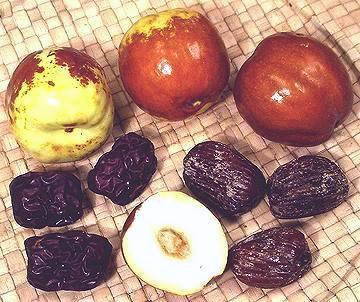 [Red Date, Chinese Date, Honey Date; Annab (Persia, dried); Taejuja
(Korea); Hong zao (China, dried), Hei zao (China, dried and smoked);
Ziziphus zizyphus]
[Red Date, Chinese Date, Honey Date; Annab (Persia, dried); Taejuja
(Korea); Hong zao (China, dried), Hei zao (China, dried and smoked);
Ziziphus zizyphus]
Jujube fruit trees were first domesticated in India about 11,000 years ago. Their natural range is uncertain because of long cultivation but may have extended from Syria to southern China. They belong to the Buckthorn family (Rhamnaceae), a fairly large family but one yielding very few edibles.
The fruit is initially green but turns red when fully ripe and eventually shrivels. It is very light, almost foam like, moderately sweet. and apple-like in flavor. The photo shows fresh (top), dried (left) and candied (right). Fresh are about 1.7 inches long, 1.6 inches diameter and weigh just over 1 ounce.
Fresh and candied jujubes are eaten as snacks. Dried they are a flavoring ingredient for soups and stews. In China dried jujubes (hong zao) may be smoked (hei zao) and will then be black instead of red. They are also used for teas and beverages. Jujube teas are reputed to be a good treatment for colds and sore throat.
Jujubies are also used in Morocco, commonly grown in the Atlas Mountains region. They are used to add sweet-sour flavors to tagines and other stews.
More on Buckthorns.